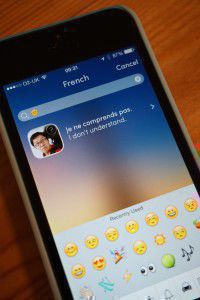The weird and wonderful language of tennis
I’m not generally much of a sports fan, and the less said about my sporting ability – or lack thereof – the better… but I do love a good tennis match. I’m a regular supporter of the British Davis Cup team (which is a lot more fun since they started winning; our humiliating weekend in Lithuania back in 2010 is, thankfully, a distant memory). I’m going to the US Open for the first time this autumn (squeal), and don’t even try booking me for any social engagements during Wimbledon fortnight – if anyone needs me then, I’ll be in front of the TV drinking Pimm’s, eating strawberries and cream and biting my nails every time Andy Murray’s on court.

Wimbledon, summer 2013
Like any sport, tennis has its own unique language and growing up watching it on TV, I had to get fluent at an early age. Besides a frankly baffling scoring system (15, 30, 40, advantage… it makes no sense at all) the game features a good few terms that may not mean a lot to newcomers, and take a while to get used to. So as the French Open comes to a close and we look ahead to the grass court season, here’s a quick guide to Tennis-ese for the uninitiated:
Love: ironically this is not something you want in a tennis match, because ‘love’ means a score of zero points in a game (or games in a set). It’s generally assumed that this comes from the French word l’oeuf, which means ‘egg’ – the same shape as a zero.
Deuce: when the score reaches 40-40 in tennis (3 points each), one player must score two consecutive points in order to seal the game. If they only manage one, the score returns to deuce, and keeps doing so until someone wins the game. ‘Deuce’ could derive from deus, Old French for two, or from à deux de jeu (‘two points from the end of the game’)… and yet, ironically, in France 40-40 is referred to as quarante à the first time, then egalité after that.
Let: when a player serves, the ball must pass over the net and bounce in the service box diagonally opposite. If it goes into the net, or misses the service box, this is a fault; do two faults in a row and you forfeit the point. But if the ball touches the net and still lands in the correct service box, this is called ‘let’. Nobody seems quite sure why, although one possibility is that it’s a shortened version of the French word for ‘net’, filet. Or it could just be because if this happens when you serve, the umpire lets you try again as many times as you need to 😉
Bagel: depending which side of the net you’re on, this is either something to celebrate or a very, very Bad Thing. A bagel occurs when one player wins a set 6-0. If this happens twice in a match it’s a double bagel. I’ve also heard a set that’s been won 6-1 referred to as a breadstick. Who knew so many tennis terms were named for the shape of food?
And finally, a couple of tennis terms with less interesting linguistic origins:
Break and Hold: the players in a tennis match take it in turns to serve. If a player wins a game on their own serve, this is called ‘holding serve’ or just ‘a hold’. On the other hand, if they manage to win a game when their opponent’s serving, this is called a ‘break’, or ‘breaking their serve’. To win a set, a player must be ahead by at least two games, so a break often proves crucial. During a tiebreak, you can also get a ‘mini-break’, which is not, as one might suppose, a short holiday but just means you’ve won a point on your opponent’s serve.
Ace: a serve that goes in but is untouched by the opponent’s racquet, automatically winning the point for the server. John Isner currently holds the record for the most aces in a match, at 115, but then again, that was also the longest singles match ever played – 11 hours, 5 minutes – at Wimbledon 2010, so perhaps it’s not so surprising.
These are just a few examples of the weird and wonderful language of tennis. What’s your favourite tennis term? And – far more importantly – who will you be cheering for at Wimbledon this year?
Liz
Language of the Week: Emoji
You may have seen on the uTalk app that you can now search for words in any of our languages by using emoji. With emoji becoming the fastest growing language in Britain, we have decided to make it our language of the week!
 If you’re anything like me, the most frequent way you choose to stay in touch with friends and family is by text messaging. If I think about it, I don’t even know what my ringtone sounds like, and I only answer my phone if I’m expecting an important call, otherwise, everyone that knows me just sends a text.
If you’re anything like me, the most frequent way you choose to stay in touch with friends and family is by text messaging. If I think about it, I don’t even know what my ringtone sounds like, and I only answer my phone if I’m expecting an important call, otherwise, everyone that knows me just sends a text.
Furthermore, I overheard this conversation the other day:
‘So he called me in the middle of the day and I thought, omg, what a freak, why can’t he just text me?‘
Okay, I was part of the conversation, but anyway you get the idea.
Nevertheless, sometimes it can be quite challenging to express your exact feelings or tone in a text, and so you risk being misunderstood by the recipient or worse – come off as too serious when you’re actually joking. So at some point in the past, the techies have come up with this brilliant way to make our text conversations more fun and emotive: emojis!
Now, some of you may not know what they are and that’s okay – my boss didn’t know either, until a couple of days ago when our app was updated with this brilliant way of searching for words by using emoji. I admit – I love emoji! They’re cute and funny and a great way to interact with your friends without using actual words.
Did you know?
- The word emoji comes from Japan, with the ‘e’ meaning picture and ‘moji’ meaning character or letter.
- There are more than 6 billion emoji sent worldwide everyday, with more than half of these being smiley faces.
- Some emoji are confusing…
- Herman Melville’s 1851 novel Moby Dick has been translated into emoji; the book was released with the title Emoji Dick.
- Many celebrities love emoji, with Roger Federer recently tweeting his whole day in emoji during Wimbledon. And in April, Andy Murray tweeted his wedding day in emoji:
🌞☔😂👔💅💇😂👰😂🚗💒💃👫🙏💍💏👏📝🎹📷🎥🚗🍷🍴🎂🎊🎉👯🎶🎤🍹🍻🍷🍺🍩🍦🍷🍹🍸🍺🌙❤💕😘💤💤💤💤💤💤💤
— Andy Murray (@andy_murray) April 11, 2015
- Even Australia’s Foreign Affairs minster, Julie Bishop gave the first ever political emoji interview on Buzzfeed.
So go ahead and see which ones have been matched with which uTalk words by our brilliant developers! Which is your favourite emoji? We love to hear from you, so please do join in the conversation here on the blog, or on Facebook or Twitter.
Ioana and Alex


